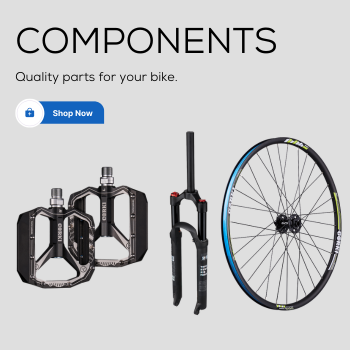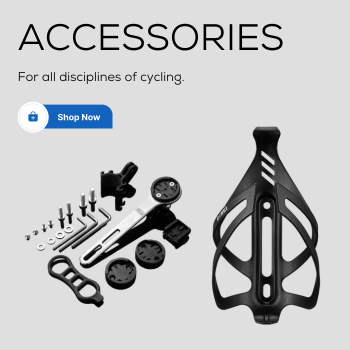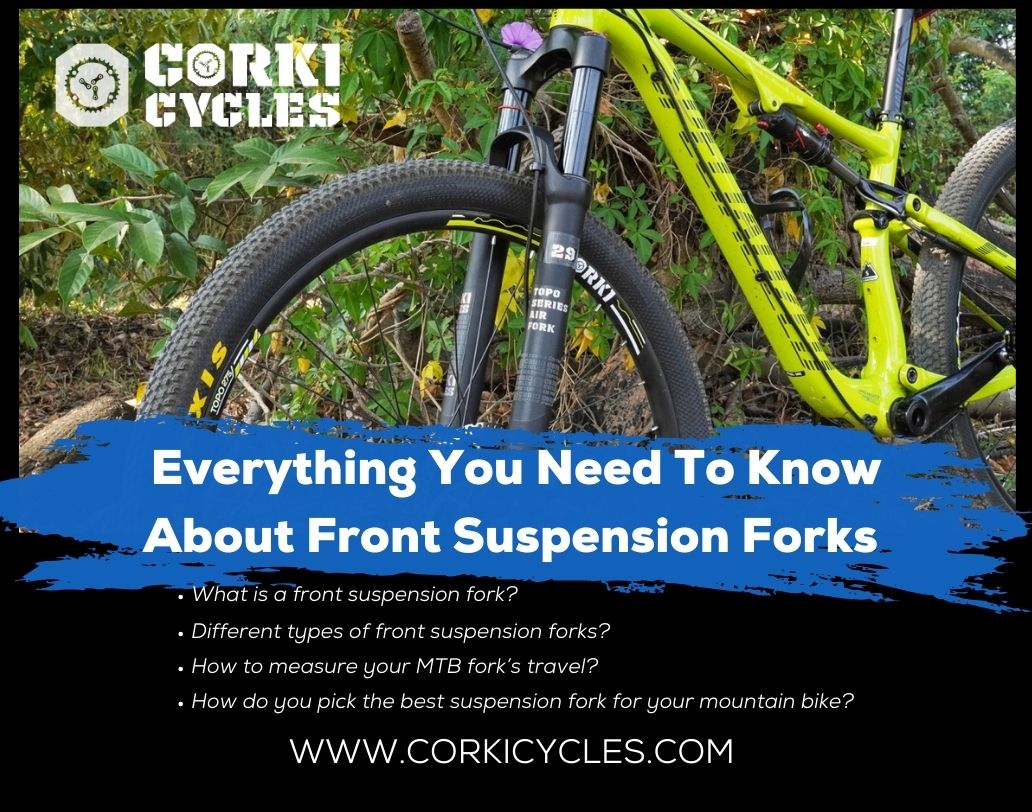
Everything You Need to Know About Front Suspension Forks
The front suspension fork is one of the essential components of a bicycle. Without a suspension fork, your bike will vibrate and make your arms sore when you go through tough terrain such as jumps and drops. Furthermore, an unsuitable fork may lead to accidents and other dangerous situations. To avoid this and improve your riding preferences, you can choose the right suspension fork for your bike.
In this guide, I will go over the fundamentals of suspension forks, and how to pick the right front suspension fork for your bike. Below is the outline of what we shall cover.
- What is a front suspension fork?
- Different types of MTB front suspension fork
- How to measure your mtb fork travel?
- How do you pick the best suspension fork for your mountain bike?
- Conclusion
What is a front suspension fork?
The suspension fork is a core bicycle component. It is typically composed of springs and dampers. Front forks comprise two stanchions (or tubes) connecting to the bike's steerer tube on the front wheel. The front suspension fork's function is to absorb trail obstacles' energy through compression, making your ride experience more comfortable.

The suspension fork offers a range of adjustments on mountain bikes. Variations include the lockout, amount of travel, and rebound adjustments. We've compiled a list of some functions of bicycle suspension forks below.
Lockout
A lockout is a small switch that is located on your mountain bike's front right stanchion. This lets you lock the suspension fork while riding out of the saddle on level ground. This means not engaging in suspension. If you're hanging out of the saddle on horrible ground, you'd better turn off this lock switch. Moreover, this switch, known as a remote lockout, can also be routed to the bike's handlebars.

Spring
The spring is found in the fork legs with the dampers. It absorbs the energy created by an impact. The stiffness of a spring is different and it is the spring rate, the ratio of force per distance the spring is compressed. You can adjust the spring rate according to your needs. Furthermore, the spring can store energy. Releasing it when the fork extends, while the damper converts excess energy. All suspension forks utilize a spring or air.
Damper
The damper is typically located inside the fork's lower legs. It can be found in the fork leg and consists of a piston and oil-filled chambers. The damper's function is to convert the spring's kinetic energy. It does this by forcing oil through adjustable ports. As the fork compresses and rebounds, the piston moves through the oil, creating resistance that slows down the movement of the fork. Several dampers are used, including hydraulic, pneumatic, and coil-sprung dampers. But it depends on many factors, such as the rider's weight, riding style, and terrain.
Travel
Travel refers to the distance of the compression and rebound. In other words, it means how far the fork's immersion tubes dip into the standpipes. The amount of spring or air travel in a suspension fork is determined by the design of the fork and the riding style. For example, a suspension fork's travel for cross-country riding will be less than downhill. Because cross-country riders typically encounter more minor obstacles and not huge road gaps.

The spring travel is always given in millimeters. The general MTB front suspension travel ranges from 80mm to 200mm. 150mm and above will have a crown design. With some suspension mountain bike forks, the spring travel can be adjusted. But it's worth noting that not all suspension forks use springs to provide travel. Some forks use air pressure instead, which can be adjusted to suit the rider's weight and riding style.
Rebound damping
Damping is the process of absorbing impact energy transmitted through the forks or shock during compression and rebound strokes. A set of forks, shocks, or struts are considered dampers. This damping determines the speed at which the fork extends after an impact.
Rebound damping is built into every suspension fork, and the strength of this damping can be adjusted on most forks. If rebound damping is too low (-), the suspension will extend too fast and feel bouncy and out of control. But suppose the rebound damping is too high (+). Then, the suspension will not recover fast enough after repeated impacts sinking ever lower into its travel and performing poorly. You can adjust the rebound damping according to your need and terrain you regularly ride.
Compression
The speed at which the fork compresses is controlled by the damping. For example, when a rider hits a bump on the trail, the suspension fork compresses to absorb the impact and rebounds to its original position. Compression can be adjusted on most suspension forks. It allows the rider to customize the amount of compression based on the terrain they are riding. A firmer compression setting is ideal for smooth, fast trails, while a softer one is better for technical, rocky terrain.
Different types of MTB front suspension forks
There are several mountain bike front suspension forks on the market nowadays, including coil springs, air springs, hydraulic, and so on. Each has unique characteristics and advantages. Here, we'll concentrate on coil springs and air spring forks, two of the most popular varieties.

Coil spring fork:
Traditional suspension forks are made of coil springs. To reduce shock and give a smooth ride, they use a metal coil as the spring. These forks are strong and require little maintenance. They cost less than air spring forks. Riders on a tighter budget frequently prefer coil spring forks.
However, coil spring forks can be heavy for some riders. The metal coil spring adds weight to the fork, making it more challenging to maneuver the bike. Additionally, adjusting the spring rate on a coil spring fork can be more complicated than on an air spring fork. Riders may need to swap out the coil spring for a different one to achieve the desired level of stiffness or softness.
Air Spring Forks
Air spring forks use compressed air to provide suspension. They are typically lighter than coil spring forks. An air spring is easier to set up because you only need a shock pump to make it stiffer or softer. Riders can adjust the spring rate by adding or releasing air pressure.
One potential downside of air spring forks is that they need more maintenance. Riders must regularly check the air pressure and add air as needed. Additionally, air spring forks can be more expensive than coil spring forks.
How to measure your MTB fork's travel?
Ever wondered how to measure the travel of your MTB fork? Well, in this section, I'll walk you through a couple of simple ways to measure your mountain bike fork travel. So grab your tape measure, and let's dive in!
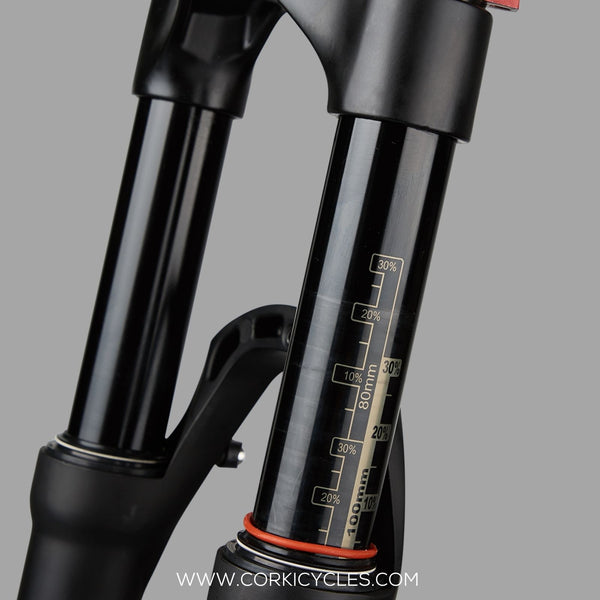
One way to find out your fork travel is by checking the manufacturer's details. Usually, they provide this information right on the fork itself. Take a close look at the fork's outlook, and you might spot the travel measurement written there.
Another way is to measure by yourself with a tape measure. If you want to be hands-on and measure it yourself, no worries! Get your tape measure ready, and let's get started.
First, slide the fork stanchions all the way down until they can't go any further. Then, measure the distance from the top of the stanchions to the fork crown with your tape measure. However, you need to pay attention to the fact that it is an approximation. You will need to subtract the compressed height of the spring for a more precise measurement. For example, if you measure 126mm but the fork's travel is stated as 120mm, you may need to subtract around 5-6mm for the compressed height of the spring. That means your mountain bike fork's travel is approximately 120mm.

How do you pick the best suspension fork for your mountain bike?
Not all suspension forks will fit your bike. Thus, you must know several critical sizes of MTB forks.
Wheel size:
The suspension fork must fit the diameter of the front wheel and wheelset you ride. There are a few different wheel sizes for mountain bikes. 26 ", 27.5", and 29" are the most common. If you are still determining your wheel size, it should be found on the side of the tire or on your hub usually.
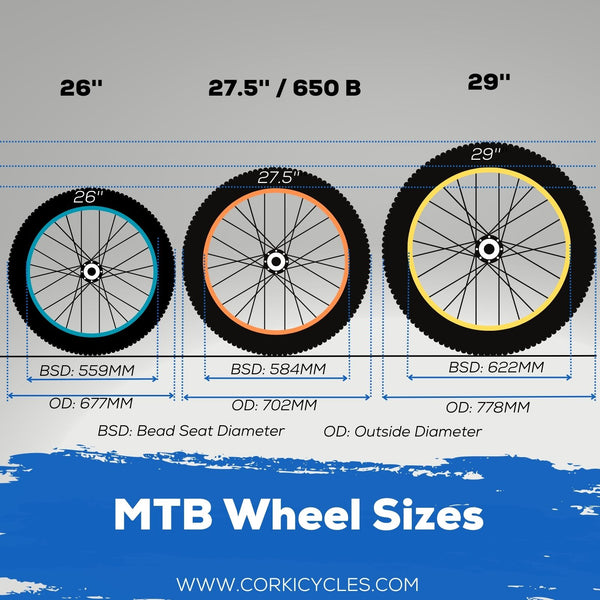
Travel:
The frame manufacturer has designed the bike around a certain amount of travel. That is why the travel of the new fork should correspond to the travel of the previously mounted fork. The general MTB front suspension travel ranges from 80 mm to 200 mm. It is generally advisable to stay within this range depending on your frame. Please check your travel carefully before you buy a new front suspension fork. Because increased or decreased fork travel can damage the tube as well as affect rideability. For example, you can't mount a 200mm travel triple crown fork on a hardtail. The steer tube angle would be crazy!
Fork steerer tube diameter:
The fork steerer tube attaches to the bicycle frame and is inserted into the frame's head tube. Most modern bikes will have a tapered steerer. It usually starts at 1.5 inches on the bottom and goes from 1 to 1/8 inches on the top. This size always offers greater stiffness with minimal weight gain.
But you may find some DH bikes and older mountain bikes have straight steerer tubes. This straight steerer can connect the fork to the original frame of the bicycle directly. Again, they range from 1 to 1/8 inch in most cases. Drop the forks out of the frame if you need clarification on the size. You should be able to see immediately if the steerer is tapered or straight.
Axle size:
The fork end must fit the front wheel's hub and axle. Suppose the suspension fork’s installation length deviates from the axle size.
The standard size for thru-axle forks on mountain bikes is 15mm x 100mm or 15mm x 110mm with 20mm x 110mm also. They are used mainly on downhill and freeride bikes. Trail, XC, and enduro bikes are changed to the newer Boost thru-axle standard. It has increased the front axle length to 110mm. If you are not sure what the size of your axle is, you can look at the previous one. Again the fork will either be built for a QR wheelset or a thru axle wheelset. Make sure to check your bike and the new suspension fork's compatibility.
Conclusion
Replacing your fork can bring about some major performance benefits, but it's critical to identify the proper type for your bike. Travel, wheel size, axle type, steer tube type, travel amount, and fork steer tube diameter are all elements to consider. With so many factors to consider, you can find the best suspension fork for your bike that matches your demands and allows you to conquer even the most difficult terrain with ease.
Have fun out there on the trails!
If you have any comments or questions, please leave them below.
Suspension Fork Related Articles:
How Do I Adjust My Front Fork Suspension Quickly?
How Do You Mount an MTB Front Suspension Fork? Quick and Easy Guide
Mastering Mountain Bike Fork Maintenance: Expert Tips for Peak Performance

